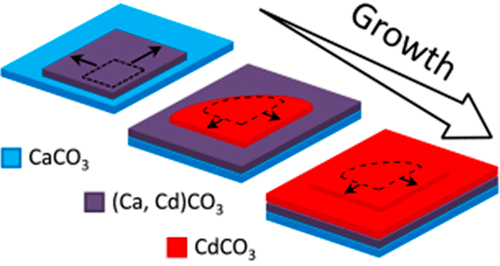当前位置:
X-MOL 学术
›
Cryst. Growth Des.
›
论文详情
Our official English website, www.x-mol.net, welcomes your
feedback! (Note: you will need to create a separate account there.)
Anisotropic Growth of Otavite on Calcite: Implications for Heteroepitaxial Growth Mechanisms
Crystal Growth & Design ( IF 3.2 ) Pub Date : 2017-12-21 00:00:00 , DOI: 10.1021/acs.cgd.7b01055 Shawn L. Riechers 1 , Sebastien N. Kerisit 1
Crystal Growth & Design ( IF 3.2 ) Pub Date : 2017-12-21 00:00:00 , DOI: 10.1021/acs.cgd.7b01055 Shawn L. Riechers 1 , Sebastien N. Kerisit 1
Affiliation

|
Elucidating the molecular-scale mechanisms driving complex growth behaviors during heteroepitaxial growth in aqueous media has remained a challenging endeavor. Toward this goal, in situ atomic force microscopy was employed to image the heteroepitaxial growth of otavite (CdCO3) at the (101̅4) surface of calcite (CaCO3) single crystals in static aqueous conditions. Heteroepitaxial growth proceeded via spreading of three-dimensional (3D) islands and two-dimensional (2D) atomic layers at low and high initial saturation levels, respectively. Experiments were carried out as a function of applied force and imaging mode thus enabling determination of growth mechanisms unaltered by imaging artifacts. This approach revealed the significant anisotropic nature of heteroepitaxial growth on calcite in both growth modes and its dependence on supersaturation, film thickness, and substrate topography. The 3D islands not only grew preferentially along the [421̅] direction relative to the [010] direction, resulting in rod-like surface precipitates, but also showed clear preference for growth from the island end rich in obtuse/obtuse kink sites. Pinning to step edges was observed to often reverse this tendency. In the 2D growth mode, the relative velocities of acute and obtuse steps were observed to switch between the first and second atomic layers. This phenomenon likely stems from significant Cd–Ca intermixing in the first layer, despite bulk thermodynamics predicting the formation of almost pure otavite. Composition effects may also be responsible for the inability of 3D islands to grow on 2D layers in cases where both modes were observed to occur simultaneously. Overall, the complex heteroepitaxial growth in general and thickness-dependent growth mechanisms in particular provide insights into the interplay of several growth factors and suggest that intermixing may play an important role.
中文翻译:

方解石上Otavite的各向异性生长:对异质外延生长机理的启示
阐明在水介质中异质外延生长过程中驱动复杂生长行为的分子尺度机制仍然是一项艰巨的努力。为了实现这一目标,采用原位原子力显微镜对方解石(CaCO 3)(101̅4)表面的凹凸棒石(CdCO 3)的异质外延生长进行了成像。)在静态水性条件下的单晶。通过分别在低和高初始饱和水平下扩展三维(3D)岛和二维(2D)原子层来进行异质外延生长。根据施加的力和成像模式进行了实验,因此能够确定不受成像伪影影响的生长机制。该方法揭示了两种生长模式下方解石上异质外延生长的显着各向异性及其对过饱和度,膜厚和衬底形貌的依赖性。3D岛不仅相对于[010]方向沿[421̅]方向优先生长,从而导致杆状表面沉淀,而且3D岛从富含钝角/钝角扭结位的岛端显示出明显的生长偏好。观察到钉扎到台阶边缘通常可以扭转这种趋势。在二维生长模式中,观察到锐角和钝角台阶的相对速度在第一和第二原子层之间切换。尽管大量的热力学预测了几乎纯的卵石的形成,但这种现象很可能是由于第一层中Cd-Ca的大量混合所致。在观察到两种模式同时发生的情况下,合成效果也可能是3D岛无法在2D层上生长的原因。总的来说,复杂的异质外延生长在一般的和依赖于厚度的生长机制中,尤其提供了对几种生长因子相互作用的洞察力,并表明相互混合可能起重要作用。观察到急性和钝性台阶的相对速度在第一和第二原子层之间切换。尽管大量的热力学预测了几乎纯的卵石的形成,但这种现象很可能是由于第一层中Cd-Ca的大量混合所致。在观察到两种模式同时发生的情况下,合成效果也可能是3D岛无法在2D层上生长的原因。总的来说,复杂的异质外延生长在一般的和依赖于厚度的生长机制中,尤其提供了对几种生长因子相互作用的洞察力,并表明相互混合可能起重要作用。观察到急性和钝性台阶的相对速度在第一和第二原子层之间切换。尽管大量的热力学预测了几乎纯的卵石的形成,但这种现象很可能是由于第一层中Cd-Ca的大量混合所致。在观察到两种模式同时发生的情况下,合成效果也可能是3D岛无法在2D层上生长的原因。总的来说,复杂的异质外延生长在一般的和依赖于厚度的生长机制中,尤其提供了对几种生长因子相互作用的洞察力,并表明相互混合可能起重要作用。尽管大量的热力学预测了几乎纯的卵石的形成。在观察到两种模式同时发生的情况下,合成效果也可能是3D岛无法在2D层上生长的原因。总的来说,复杂的异质外延生长在一般的和依赖于厚度的生长机制中,尤其提供了对几种生长因子相互作用的洞察力,并表明相互混合可能起重要作用。尽管大量的热力学预测了几乎纯的卵石的形成。在观察到两种模式同时发生的情况下,合成效果也可能是3D岛无法在2D层上生长的原因。总的来说,复杂的异质外延生长在一般的和依赖于厚度的生长机制中,尤其提供了对几种生长因子相互作用的洞察力,并表明相互混合可能起重要作用。
更新日期:2017-12-21
中文翻译:

方解石上Otavite的各向异性生长:对异质外延生长机理的启示
阐明在水介质中异质外延生长过程中驱动复杂生长行为的分子尺度机制仍然是一项艰巨的努力。为了实现这一目标,采用原位原子力显微镜对方解石(CaCO 3)(101̅4)表面的凹凸棒石(CdCO 3)的异质外延生长进行了成像。)在静态水性条件下的单晶。通过分别在低和高初始饱和水平下扩展三维(3D)岛和二维(2D)原子层来进行异质外延生长。根据施加的力和成像模式进行了实验,因此能够确定不受成像伪影影响的生长机制。该方法揭示了两种生长模式下方解石上异质外延生长的显着各向异性及其对过饱和度,膜厚和衬底形貌的依赖性。3D岛不仅相对于[010]方向沿[421̅]方向优先生长,从而导致杆状表面沉淀,而且3D岛从富含钝角/钝角扭结位的岛端显示出明显的生长偏好。观察到钉扎到台阶边缘通常可以扭转这种趋势。在二维生长模式中,观察到锐角和钝角台阶的相对速度在第一和第二原子层之间切换。尽管大量的热力学预测了几乎纯的卵石的形成,但这种现象很可能是由于第一层中Cd-Ca的大量混合所致。在观察到两种模式同时发生的情况下,合成效果也可能是3D岛无法在2D层上生长的原因。总的来说,复杂的异质外延生长在一般的和依赖于厚度的生长机制中,尤其提供了对几种生长因子相互作用的洞察力,并表明相互混合可能起重要作用。观察到急性和钝性台阶的相对速度在第一和第二原子层之间切换。尽管大量的热力学预测了几乎纯的卵石的形成,但这种现象很可能是由于第一层中Cd-Ca的大量混合所致。在观察到两种模式同时发生的情况下,合成效果也可能是3D岛无法在2D层上生长的原因。总的来说,复杂的异质外延生长在一般的和依赖于厚度的生长机制中,尤其提供了对几种生长因子相互作用的洞察力,并表明相互混合可能起重要作用。观察到急性和钝性台阶的相对速度在第一和第二原子层之间切换。尽管大量的热力学预测了几乎纯的卵石的形成,但这种现象很可能是由于第一层中Cd-Ca的大量混合所致。在观察到两种模式同时发生的情况下,合成效果也可能是3D岛无法在2D层上生长的原因。总的来说,复杂的异质外延生长在一般的和依赖于厚度的生长机制中,尤其提供了对几种生长因子相互作用的洞察力,并表明相互混合可能起重要作用。尽管大量的热力学预测了几乎纯的卵石的形成。在观察到两种模式同时发生的情况下,合成效果也可能是3D岛无法在2D层上生长的原因。总的来说,复杂的异质外延生长在一般的和依赖于厚度的生长机制中,尤其提供了对几种生长因子相互作用的洞察力,并表明相互混合可能起重要作用。尽管大量的热力学预测了几乎纯的卵石的形成。在观察到两种模式同时发生的情况下,合成效果也可能是3D岛无法在2D层上生长的原因。总的来说,复杂的异质外延生长在一般的和依赖于厚度的生长机制中,尤其提供了对几种生长因子相互作用的洞察力,并表明相互混合可能起重要作用。











































 京公网安备 11010802027423号
京公网安备 11010802027423号